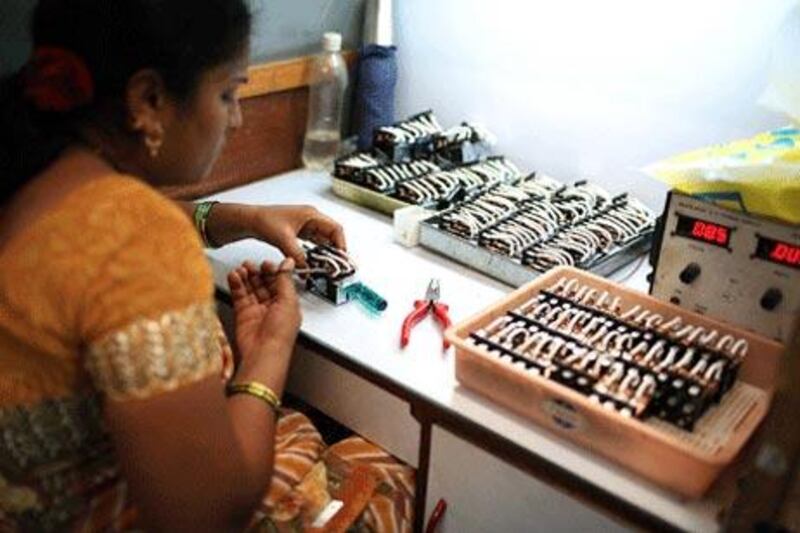PUNE, INDIA // At Tara Relays, a one-room factory tucked away in the rear of a decrepit industrial estate, work is in full swing by midday. Amid the shrill whirring of machines, nearly half a dozen workers seated on chairs gingerly assemble by hand a cluster of relays, an electrically operated switch with myriad industrial applications.
The finished relays, each comprising a crimson coil of wire wound around a soft iron core, are neatly stacked on plastic trays. But this activity masks the painful slump that has hit Tara Relays hard in recent years. Its turnover has plunged by more than 40 per cent compared with a decade ago and its market share has been steadily eroded by a tide of cheaper Chinese alternatives that have swamped the Indian market since early last decade.
"Chinese relays have completely swept the market," says Kunal Supnekar, the director of Tara Relays. "Our prospects have been reduced to survival, not growth." Tara Relays is not the only Indian manufacturer facing the heat of stiff Chinese competition. A survey last year by the Federation of Indian Chambers of Commerce and Industry shows that the country's small and medium-sized enterprises are feeling the heat of rising imports from China, which sell at prices 10 per cent to 70 per cent lower than their Indian counterparts.
"Made in China" labels are slowly, but inexorably, capturing the domestic market in segments such as food processing, light and heavy engineering goods, electronic products, chemical products, garments and metal and car components. Critics say their success is the result of their "predatory pricing" aimed at capturing the Indian market. "No one warned us about the Chinese threat," says Mr Supnekar. "After years of a stable market, suddenly, one fine day, a customer walked up to us and said, ''you are selling your relay for 15 rupees (Dh1.18), when a Chinese one is available for 4 rupees. Why should I buy from you?'"
China, a growing Asian giant with a ravenous appetite for the world's raw materials, has also been aggressively peddling its finished goods, from tyres to mobile phones, around the world. Fifty-four per cent of the total manufacturing in China caters to the export market, the mainstay of the Chinese economy. The country recently surpassed the US to become the world's second-largest exporter after Germany. The World Trade Organisation (WTO) predicts it will even outpace Germany in exports this year.
So far, developed economies such as the US and the EU have been complaining about Chinese imports eating into domestic businesses. Now, developing countries such as India are openly vocal about the pinch of Chinese imports. "China's integration into the global economy, because of its sheer size, has far-reaching consequences for the global economy and imposes difficult adjustment challenges for many countries, developing and developed alike," says Pieter Bottelier, a senior adjunct professor of China studies at Johns Hopkins University in the US.
Once synonymous with poor quality and low price, Made in China labels have improved their reputation, making it even tougher to compete with them, Indian manufacturers say. "For a long time, I would scratch my head and wonder how the Chinese manage to sell at dirt cheap prices without compromising on quality," Mr Supnekar says. "Even if I compromise on my profit margins, I cannot afford to sell at those rates."
The Chinese are bulk manufacturers, Mr Supnekar realised, with a well-developed vendor base, reducing supply-chain costs. Others have found additional factors. "Our study reveals that some of the factors that can be attributed to China's cost advantage are lower raw material costs, higher labour productivity, lower level of indirect taxes and import duties," says NV Sivakumar, an executive director who leads the retail industry practice with the consultancy firm PricewaterhouseCoopers in India.
Critics say the Chinese government gives its manufacturers a slew of incentives to boost exports. "China has provided subsidies across sectors with special focus on segments that are strategically important. There has also been a thrust on R&D [research and development] through government programmes and tax incentives -," Mr Sivakumar says. While a Chinese component manufacturer gets a 33 per cent return on investment due to a government rebate on indirect taxes, an Indian counterpart gets only 11 per cent, says Robert John, the president of the trade group Electronics Industries Association of India. And finance is available in China at 4 per cent, whereas it costs 12.5 per cent in India. The cost of power in India is about 8 rupees per unit compared with 2.50 rupees in China.
"We are at a disadvantage over our Chinese competitors," Mr John says. "This is no longer a level playing field." To tackle the advantages of the Chinese goods, Indian companies are demanding that trade restrictions on Chinese imports be increased. Early last year, the Indian government imposed a blanket ban on Chinese toys, which it had to lift after China threatened to lodge a complaint with WTO.
In recent months, India has imposed anti-dumping duties, tariffs aimed at imports sold at a price deemed unfairly low, on a slew of goods to safeguard domestic industry. Just last week, the Indian government imposed an anti-dumping duty of 209 rupees per metre on imports of flax fabrics from China and Hong Kong, primarily used in curtains. India's directorate general of anti-dumping and allied duties recommended the duty after an investigation determined that cheap Chinese flax fabrics could be detrimental to the domestic sector.
World Bank data shows that in the third quarter of last year, India, Argentina, the US and the EU combined to initiate 56.8 per cent of the new anti-dumping investigations, most of them targeted at China. But such remedies would not deter competition from Chinese imports given the yawning price difference between Indian and Chinese goods, some manufacturers say. In recent years, some manufacturers find it more lucrative to import Chinese products and sell them under their own label.
Some domestic companies are importing phones from China and Hong Kong and selling them after affixing their brand names, and offering warranties and after-sales services not provided by the non-branded Chinese products. India's Reliance Communications, India's second-largest telecommunications service provider, and Tata Indicom, another telecoms giant, have in recent years bought Chinese CDMA mobile handsets in bulk from Chinese companies such as ZTE and Huawei to sell under their own name.
In October, China Wireless Technologies tied up with Reliance Communications to launch its dual-SIM smartphone in India, and aims to generate revenues of 8 billion rupees in the next five years. "Manufacturers are now turning traders to beat Chinese competition," says Mr Supnekar, who has fought the pressure to shut his manufacturing unit and become an importer of Chinese relays. "If prices of Chinese goods rise in the next five years, I want to be around to compete with them with my own brand."
@Email:achopra@thenational.ae
China mauls India's industry
As Chinese imports flood India, domestic manufacturers urge the government to tackle unfair competition.

Editor's picks
More from the national




